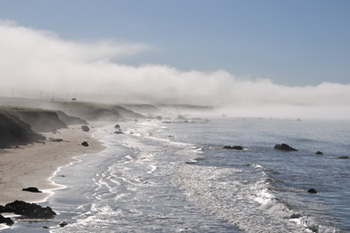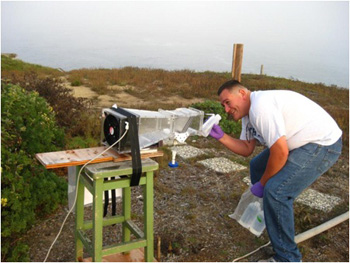An ongoing investigation of elevated mercury levels in coastal fog in California suggests that upwelling of deep ocean water along the coast brings mercury to the surface, where it enters the atmosphere and is absorbed by fog.
Peter Weiss-Penzias, an environmental toxicologist at the University of California, Santa Cruz, who leads the investigation, emphasized that the amount of mercury in fog is not a health concern. "These are parts-per-trillion levels, so when we say elevated, that's relative to what was expected in atmospheric water," he said. "The levels measured in rain have always been fairly low, so the results from our first measurements in fog were surprising."
Weiss-Penzias and his team collected their first fog samples in the summer of 2011 and published their findings in a paper in Geophysical Research Letters in February 2012. The team, including researchers at Moss Landing Marine Laboratories and CSU Monterey Bay, collected additional fog samples in the summer of 2012 and also analyzed water samples collected at different depths in Monterey Bay. Weiss-Penzias presented the latest findings in a talk at the American Geophysical Union meeting in San Francisco on Tuesday, December 4.
Mercury is a highly toxic element that is released into the environment through a variety of human activities, including the burning of coal. In California, mercury mines in the coast ranges produced large amounts of elemental mercury for use in gold mining operations, leading to contamination of watersheds throughout the state. Bacteria in soil and sediments transform elemental mercury into methylmercury compounds that are especially toxic and readily absorbed by organisms.
Weiss-Penzias said the new results provide some clues to how methylmercury gets into coastal fog, although more research is needed to understand the processes involved. He is particularly interested in a highly volatile compound called dimethylmercury. "Dimethylmercury is more stable in the deep ocean, but we're not quite sure how it forms or where it's coming from," he said. "We found elevated levels in the surface water during upwelling, and it readily evaporates from the surface into the atmosphere, where it decomposes into monomethylmercury and gets into fog droplets."
When the fog moves onto the land, it collects on the leaves of redwood trees and other vegetation and drips onto the ground, depositing significant amounts of mercury onto the land. "We calculated that more methylmercury is deposited by fog than by rain, but the error bars are large," Weiss-Penzias said. He is hoping to get grant funding to conduct a more comprehensive research project.
The preliminary results obtained so far have relied heavily on the efforts of undergraduate researchers working with Weiss-Penzias and Russell Flegal, professor of microbiology and environmental toxicology at UC Santa Cruz. Two of those undergraduates will be presenting posters on their work at the AGU meeting. Cruz Ortiz, who has continued working in the lab since his graduation earlier this year, has been looking at mercury concentrations in insects in coastal areas subject to fog deposition. His preliminary data indicate higher concentrations of mercury in some insects in the summer, when coastal fog is common, than in February and March. The other poster looks at mercury in sediments from Monterey Bay and is presented by Rene Paul Acosta, now a graduate student at Purdue University.
"There is so little data on this now, we're just trying to fill in the map to improve our understanding of the cycling of mercury in the environment," Weiss-Penzias said. "We want to know its sources and sinks and transformations."
Methylmercury becomes increasingly concentrated in organisms higher up the food chain, and mercury levels in some predatory fish are high enough to raise health concerns. This contamination of ocean fish is the result of biological sequestering of mercury that has been accumulating in the oceans since the beginning of the industrial revolution in the 19th century. Similarly, the mercury that moves from ocean waters into fog is probably not fresh pollution, but the result of the historical legacy of mercury pollution from coal burning and other sources, Weiss-Penzias said.
"It is a bit of a mystery where it's coming from, but I think what we're seeing is a large-scale phenomenon that has to do with upwelling of deep ocean water along the coast," he said.




